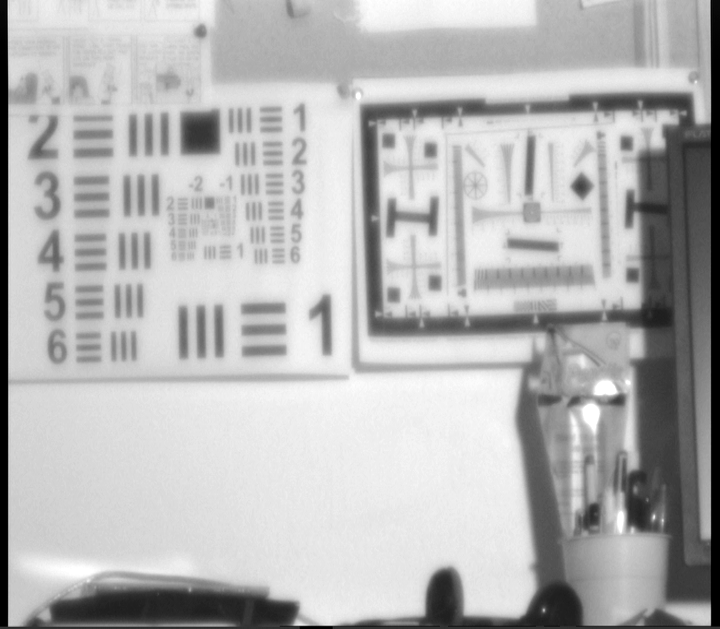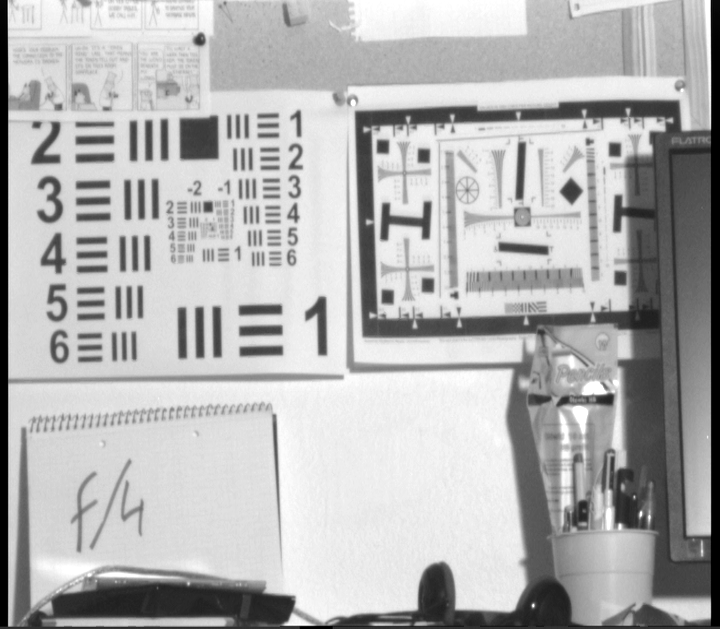


polprog, 23 feb 21. Click on an image to see a full size version
I decided to modify one of my CS-mount cameras to be C-mount. This allowed me to use a cool Fujinon lens I had, as well as any future C-mount lenses I might get, on the camera. I described the mechanical modification and theory behind it in this previous post. All the images from the camera were captured using my rig with a 4 channel compsite video frame grabber card.
Before putting everything together, let's test focus within a range of distances I connected the cables back to the sensor board and installed the Fujinon lens on the chassis. I was happy to see that it could focus easily in a wide range of focal lengths (it is a zoom lens after all) and object distances. The only issue was that I needed to step the aperture down to f/2.8 (or sometimes even f/4). That is not a big problem. I doubt that the sensor board was exactly 12.526mm away from the flange originally anyway - it probably didn't matter much, as the CCTV lenses have incredible focus range (the ones I have can focus on, or even closer than, the dust on the surface of the outermost lens!)
I was also lucky in estimating if there was enough space between the sensor board and the power supply, as the whole thing went back together pretty easily. Now I can use my favourite C-mount lens with this camera.

Testing the newly modified camera, pointed at an ISO 12233 chart hanging on the corkboard at the other desk. (The image on the monitor was sharp, the photo is focused on the camera body instead of the monitor)
Having just built the analogue video gear rack, I grabbed some frames with the framegrabber card (the same that I linked above). I think that the sensor is a little too far away from the lens now, however, as I mentioned, it can take sharp images at f/4 as seen here (keep in mind that all these frames are Standard Definition, 640x480. You have to believe me when I say this is the sharpest they can be ;) ! )
Two frames captured at different f-stops. The left image, at f/1.2, was still slightly out of focus at the limit of the focus ring. The right image at f/4 is sharp at the same focus setting.
Being a CCTV camera, it has some amazing low-light performance. This frame, showing a part of the shelf at the other desk, was taken at f/4, at about 75mm focal length, while the CDs were illuminated by light from a 50W desk lamp on the opposite desk. Measuring the same scene with a DSLR yielded settings that work out to approximately 4.7 EV
Despite being C-mount now, the modified camera still can "work" with CS-mount lenses - albeit producing very strange images. A photographer would say that they are unique, but an imaging engineer would find them awfully aberrated...
As it turns out, the CS-mount lenses I have can still create an image on the modified camera. They can only do that on the Tele-end of the focal length adjust and only with objects at a very close distance (about 30 cm).
Various frames grabbed from the modified camera with a CS lens installed
These images are recognizable but they have some very large comatic aberrations. Images "focused" on larger distances also expose some sperical aberration. This is due to the lens operating way out of it's designed focusing range and ability, so it's to be expected. Nonetheless it creates some interesting effects. The aberration seems to be larger when the lens focal length is set wider.
You can get some sharp edges if you close down the aperture by a large amount. I captured this frame below while puting my hand in front of the camera so that the slit beween my fingers created a sort-of second aperture (Compare this with the first image in the group above)
The same modified camera, CS-lens, seeing the USAF test chart through a slit between fingers acting as an aperture
Of course this comes at a cost - there's less light coming though the lens (it is, after all, partially obstructed) - so the autoexposure circuitry has to increase the sensor gain. The noise level goes up noticeably, and the contrast is very poor. On the other hand, the numbers on the test chart are more legible.
Remember how I mentioned the CCTV lenses have absolutely amazing focal range? Here is a frame where the lens is focused on the dust on the lens surface.
Dust on the lens surface as seen through the lens. That is not the closest that the focus ring can go, but it's the closest usable focus setting. Taken with the same CS lens, although on a different, CS-mount color camera.
Overall I'm happy with how this modification turned out. I now have a C-mount SD camera that can be used in various other experiments. Hacks and other experiments like this, lead to many insights into inner workings of these devices. That comes handy when designing optical systems with low cost cameras, for instance for image capturing or Computer Vision purposes. I'm looking forward into experimenting with machine vision, and being able to use a larger selection of lenses is definitely helpful.
If you found this post interesting, you may also find the other ones interesting too. Click on the link below to go to the main page which lists all of them.